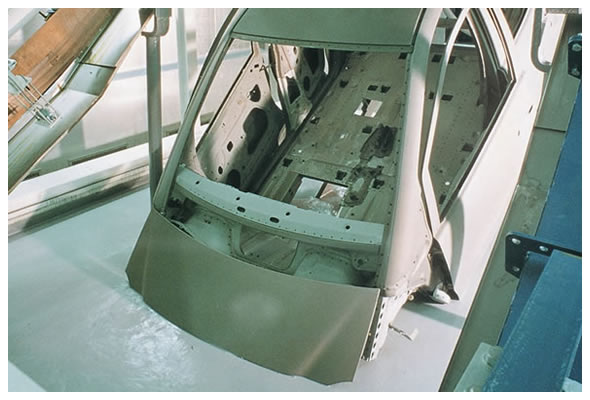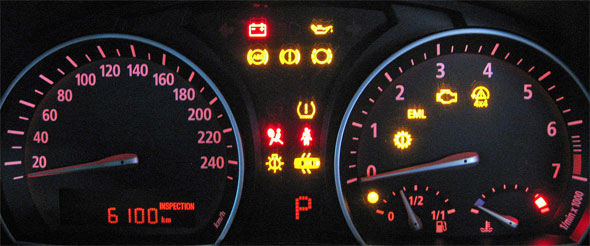Inspecting the car interior and exterior
01 Sep 2007|34,930 views
 |
| The original paintwork is always highly valued as it is dip-painted, not spray-painted. |
Examine the appearance of the vehicle by walking around it slowly, inspecting it at all angles. Don't be too concerned with a few nicks and scratches - no used car will be in perfect condition.
Signs of repainting
Check for rust
Although a little surface rust around objects like exterior screws is generally not considered severe, check all rust carefully. Inspect any "add-on" side moldings, base of doors, wheel wells, window trim, headlight compartments - do try to spot rust under the car. Inside, try to examine under both front and rear carpets. Look inside the trunk and under the trunk mat or carpet. If you see serious rust - you should turn around and walk away from the car.
Check windshield and car chassis
Pits, cracks, holes or serious scratches call for glass replacement. When checking the car chassis, look for dents or scratches on the paintwork. If you can find any of these faults, use them as good bargaining chips when negotiating on the price.
The interior
Take a good look at the overall condition. Is it clean or exceptionally dirty? Are there rips in the upholstery? Is the carpet worn? How about the rubber on the pedals? Sometimes, this is a good indication the car had experienced much wear and tear. Do not forget to check the dashboard for any cracks.
Check all the gauges
Be sure all gauges, knobs and gadgets are in the proper place and are in working condition. If you notice any part missing, ask what was there and why it was removed. Turn the ignition to "ON" (not start). Inspect if all gauges and warning lights are operating properly.
Test every single part of the car
This includes: the radio/stereo/tape deck/CD player; all speakers and antenna; air conditioner; remote-control mirrors; defroster; horn; mirror adjustments; cigarette lighter; clock; tachometer; tilt steering wheel; windshield washer and wiper; all door and window locks (power or manual); and all releases - hood, trunk and gas cap. Pay special attention when examining the windows. Be sure they roll all the way up and all the way down easily. If they do not, it could mean body damage inside the doors.
Check all the lights
A car may have as many as 15 lights. Regardlessly, please check all the lights: Dashboard lights, headlights (low, normal and high beam), glove compartment lights, ceiling (dome) light, trunk light, hazard light, map light, backup lights, fog lights, parking lights, side lights, brake lights, license plate light and turn signals. If you do not have a friend with you, request that the seller turn the exterior lights on and off while you check them from the outside.
 |
Check the mileage
In general, I would not recommend purchasing a car with a very high mileage, for example, 250,000 km and higher would be considered very high. However, "low mileage" does not necessarily mean it's going to be a "good car". Beware of cars which may have undergone restoration after a serious accident, or cars which have not been properly maintained. Having your car evaluated will certainly help you to avoid lemons with history of serious accidents.
A rough guide for the average mileage of a car would be 20,000km per year. Anything below that would mean that the previous owner underutilized the car, and that it is still in excellent condition (if the car has no history of accidents). Anything above the average mileage will be another good reason for you to ask for a lower price during negotiations
 |
| The original paintwork is always highly valued as it is dip-painted, not spray-painted. |
Examine the appearance of the vehicle by walking around it slowly, inspecting it at all angles. Don't be too concerned with a few nicks and scratches - no used car will be in perfect condition.
Signs of repainting
Check for rust
Although a little surface rust around objects like exterior screws is generally not considered severe, check all rust carefully. Inspect any "add-on" side moldings, base of doors, wheel wells, window trim, headlight compartments - do try to spot rust under the car. Inside, try to examine under both front and rear carpets. Look inside the trunk and under the trunk mat or carpet. If you see serious rust - you should turn around and walk away from the car.
Check windshield and car chassis
Pits, cracks, holes or serious scratches call for glass replacement. When checking the car chassis, look for dents or scratches on the paintwork. If you can find any of these faults, use them as good bargaining chips when negotiating on the price.
The interior
Take a good look at the overall condition. Is it clean or exceptionally dirty? Are there rips in the upholstery? Is the carpet worn? How about the rubber on the pedals? Sometimes, this is a good indication the car had experienced much wear and tear. Do not forget to check the dashboard for any cracks.
Check all the gauges
Be sure all gauges, knobs and gadgets are in the proper place and are in working condition. If you notice any part missing, ask what was there and why it was removed. Turn the ignition to "ON" (not start). Inspect if all gauges and warning lights are operating properly.
Test every single part of the car
This includes: the radio/stereo/tape deck/CD player; all speakers and antenna; air conditioner; remote-control mirrors; defroster; horn; mirror adjustments; cigarette lighter; clock; tachometer; tilt steering wheel; windshield washer and wiper; all door and window locks (power or manual); and all releases - hood, trunk and gas cap. Pay special attention when examining the windows. Be sure they roll all the way up and all the way down easily. If they do not, it could mean body damage inside the doors.
Check all the lights
A car may have as many as 15 lights. Regardlessly, please check all the lights: Dashboard lights, headlights (low, normal and high beam), glove compartment lights, ceiling (dome) light, trunk light, hazard light, map light, backup lights, fog lights, parking lights, side lights, brake lights, license plate light and turn signals. If you do not have a friend with you, request that the seller turn the exterior lights on and off while you check them from the outside.
 |
Check the mileage
In general, I would not recommend purchasing a car with a very high mileage, for example, 250,000 km and higher would be considered very high. However, "low mileage" does not necessarily mean it's going to be a "good car". Beware of cars which may have undergone restoration after a serious accident, or cars which have not been properly maintained. Having your car evaluated will certainly help you to avoid lemons with history of serious accidents.
A rough guide for the average mileage of a car would be 20,000km per year. Anything below that would mean that the previous owner underutilized the car, and that it is still in excellent condition (if the car has no history of accidents). Anything above the average mileage will be another good reason for you to ask for a lower price during negotiations









